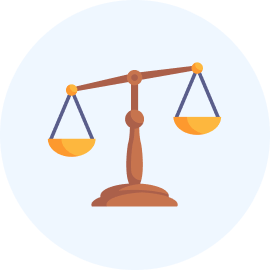Practice Questions: Ages- 1 | Quantitative Techniques for CLAT PDF Download
Q1: The total age of X and Y is 15 years more than the sum of ages of Y and Z. X is how many years older than Z?
(a) 12
(b) 13
(c) 14
(d) 15
Ans: (d)
(X+Y) - (Y+Z) = 15 ⇒ X – Z = 15. X is older than Z by 15 years.
Q2: A person's present age is one-fifth of the age of his mother. After 7 years, he will be one- third of the age of his mother. How old is the mother at present (in years)?
(a) 35
(b) 40
(c) 45
(d) 50
Ans: (a)
Let the mother's present age be x years.
Then, the person's present age = 1/5 x years. (1/5) x = 7 = (1/3)(x+7)
⇒ 3x + 105 = 5x + 35
⇒ x = 35
Q3: Seven years ago Anu was A times as old as Kitu was. If Anu is now 18 years old, how old is Kitu now in terms of A (in years)?
(a) 11/A + 7
(b) A/11 +7
(c) 17 - A/7
(d) 17/A
Ans: (a)
Let Kitu's age now be Y, Anu’s age now is X.
(X - 7) = A(Y - 7). But X is 18 and therefore 11 = A(Y - 7)
11/A = Y-7
(11/A) + 7 = Y
Q4: Suraj is younger than Rohit by 6 years. If the ratio of their ages is 3:5, find the age of Rohit.
(a) 15 years
(b) 25 years
(c) 35 years
(d) 45 years
Ans: (a)
If Rohit's age is x, then Suraj's age is x – 6.
So, (x-6) / x = 3/5
5x-30=3x ⇒ 2x=30
x=15. So Rohit's age is 15 years.
Q5: Six years ago, the average age of A, B, C, and D was 30 years. When E joined them, the average of all the five becomes 40 years. The age of E is
(a) 49 years
(b) 35 years
(c) 42 years
(d) 56 years
Ans: (d)
6 years ago average age of A,B,C,D = 30 years
∴ 6 years ago total age of A, B, C, D = 30 x 4 = 120 years
∴ Total present age of A, B, C, D = 120 + 6 x 4 = 144 years.
If E's present age is x years, (144 + x) / 5 = 40
Therefore, X= 56.
Q6: In 12 years, M will be thrice as old as N was 12 years ago. If M is now 8 years older than N, the present age of N is (in years):
(a) 28
(b) 21
(c) 14
(d) 7
Ans: (a)
Let N's present age = x years. Then, M's present age = (x + 8) years.
∴ (x + 8) + 12 = 3(x - 12)
⇒ x + 20= 3x - 36
⇒ 2x =56 ⇒ x=28
Q7: The sum of the ages of 5 children born at the intervals of 2 years each is 60 years. How old is the youngest child (in years)?
(a) 12
(b) 8
(c) 6
(d) 4
Ans: (b)
Let x be the youngest child. Each of the other four children will then be x+2, x+4, x+6, x+8.
As we know, the sum of their ages is 60.
So, x+(x+2) + (x+4) + (x+6) + (x+8) = 60
5x+20=60 ⇒ x=8
The youngest child is 8years old.
Q8: The ratio of Seema's age to the age of her mother is 5:12. The difference of their ages is 21 years. What will be the ratio of Seema's age and her mother's age after three years?
(a) 3 : 7
(b) 13:7
(c) 6:13
(d) 7:3
Ans: (c)
The ratio of Seema's age to the age of her mother is 5:12.
The difference of their ages 12x - 5x = 21, ⇒ x= 3
∴ Ratio of their ages after 3 years = 5x+3: 12x+3
⇒ 5*3+3:12*3+3
⇒ 18:39 ⇒ 6:13
Q9: If sum of three times the daughter’s age and the mother’s age is 70, and the sum of three times the mother’s age and the daughter’s age is 98. So the mother’s age is (in years)
(a) 28
(b) 21
(c) 24
(d) 27
Ans: (a)
Let daughter’s age = A and mother's age = B
Given: 3A+B = 70 and A+3B = 98. Solving B, we will get B = 28.
Q10: The age of a man is 3 times of his son. Six years ago, the man was seven times old as his son was at that time. The present age of man is
(a) 36 years
(b) 27 years
(c) 48 years
(d) 39 years
Ans: (b)
Let the son's age be x years and the father's age be 3x years.
⇒ (3x-6) = 7(x-6)
⇒ 3x-6 = 7x-42
⇒ 4x = 36
⇒ x = 9
∴ Present age of the father =3x= 3*9= 27 years
|
49 videos|179 docs|73 tests
|
FAQs on Practice Questions: Ages- 1 - Quantitative Techniques for CLAT
| 1. What are the developmental milestones for a one-year-old? |  |
| 2. How can I encourage language development in my one-year-old? |  |
| 3. Is it normal for a one-year-old to have temper tantrums? |  |
| 4. What are some appropriate toys for a one-year-old? |  |
| 5. How much sleep does a one-year-old need? |  |
















